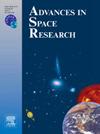Minimum hop path model for LEO mega constellation networks with inter-layer satellite links: A theoretical analytic approach
IF 2.8
3区 地球科学
Q2 ASTRONOMY & ASTROPHYSICS
引用次数: 0
Abstract
Low Earth orbit (LEO) Mega-constellation networks (MCNs) with inter-satellite links (ISLs) are of great importance in terms of broadband communications. Compared to single-layer MCNs, multi-layer MCNs with inter-layer links (ILLs) bring better throughput and invulnerability at the cost of increased routing complexity. In this paper, for the first time, a theoretical analytic approach based on the non–homogeneous Poisson distribution is proposed to estimate the hop count between any two ground users for dual-layer MCNs with different ILL densities. Meanwhile, it is demonstrated that the establishment of ILLs reflects the dynamic features of ”small world” networks, which implies that introducing a small percentage of random connections to a regular network can significantly decrease the network diameter and the average shortest path length. Additionally, the uneven spatial distribution of hop count reduction is clarified. Results demonstrate that the implementation of ILLs effectively contributes to diminishing hop count. Remarkably, a mere 6% of ILLs leads to a substantial reduction of 22.3% in hop count for Starlink. These findings are helpful to the comprehension of constellation topological properties and provide valuable guidance for routing design and the deployment of ISLs.
具有层间卫星链路的LEO大星座网络最小跳径模型:一种理论分析方法
具有星间链路的低地球轨道大星座网络(MCNs)在宽带通信中具有重要意义。与单层mcn相比,具有层间链路的多层mcn具有更好的吞吐量和不受攻击性,但代价是增加了路由复杂性。本文首次提出了一种基于非齐次泊松分布的理论分析方法来估计不同ILL密度的双层mcn中任意两个地面用户之间的跳数。同时,研究表明,ILLs的建立反映了“小世界”网络的动态特征,这意味着在规则网络中引入小比例的随机连接可以显著减小网络直径和平均最短路径长度。此外,还澄清了跳跃计数减少的空间不均匀分布。结果表明,ILLs的实施有效地减少了跳数。值得注意的是,仅6%的酒量就会导致星链啤酒花数量大幅减少22.3%。这些发现有助于理解星座的拓扑特性,并为路由设计和isl的部署提供有价值的指导。
本文章由计算机程序翻译,如有差异,请以英文原文为准。
求助全文
约1分钟内获得全文
求助全文
来源期刊

Advances in Space Research
地学天文-地球科学综合
CiteScore
5.20
自引率
11.50%
发文量
800
审稿时长
5.8 months
期刊介绍:
The COSPAR publication Advances in Space Research (ASR) is an open journal covering all areas of space research including: space studies of the Earth''s surface, meteorology, climate, the Earth-Moon system, planets and small bodies of the solar system, upper atmospheres, ionospheres and magnetospheres of the Earth and planets including reference atmospheres, space plasmas in the solar system, astrophysics from space, materials sciences in space, fundamental physics in space, space debris, space weather, Earth observations of space phenomena, etc.
NB: Please note that manuscripts related to life sciences as related to space are no more accepted for submission to Advances in Space Research. Such manuscripts should now be submitted to the new COSPAR Journal Life Sciences in Space Research (LSSR).
All submissions are reviewed by two scientists in the field. COSPAR is an interdisciplinary scientific organization concerned with the progress of space research on an international scale. Operating under the rules of ICSU, COSPAR ignores political considerations and considers all questions solely from the scientific viewpoint.
 求助内容:
求助内容: 应助结果提醒方式:
应助结果提醒方式:


